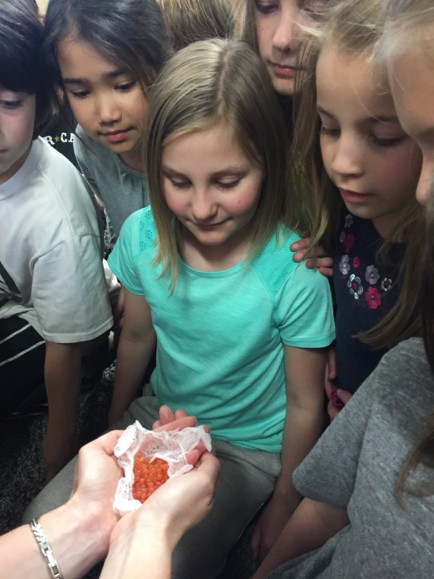Happy Spring!
Expedition: Bills and Gills
Case Study One was a success! The students commendably created two main projects, which highlighted their new knowledge. First, with a partner, they researched a biome, and then created a slideshow, which concluded with a presentation. These slideshows will be on display for Celebration of Learning. The second project was to create a game that emphasized the Sierra Nevada Biome food chains and pyramids of our native plants and animals. They fashioned high quality food chain/pyramid games such as a card game of war, cup pyramid and memory games. Craftsmanship of work was demonstrated as well as understanding of our case study.
We move into our second case study this week with the arrival of our Lahontan Cutthroat Trout Eggs. We kicked off this case study with a Science Talk Protocol using an overall guiding question, “What makes a fish, a fish?” While the students shared their observations about fish in general, they had a lot of questions about fish. I look forward to the students becoming Ichthyologists as they study all about the world of fish, their ecosystems, life cycles, food chains and adaptations. We will specifically learn about our local Sierra Nevada Fish.
Questions to ask:
What observations have you made about the lifecycle of the Lahontan Cutthroat trout?
How and why is the tank set up in the classroom?
How long will it take for an egg to hatch?
Can you identify and name all the parts of a trout’s life cycle?
What is an alevin?
What is a fry?
What is the difference between a structural and behavioral adaption?
What are some structural adaptations of Lahontan Cutthroat Trout?
What are some behavioral adaptations of Lahontan Cutthroat Trout?
What is the food web of the Lahontan Cutthroat Trout??
ELA:
April is national poetry month and we are excited to participate within our ELA time. Our crew began this with mastering figurative language and will now analyze how figurative language can be inserted into poems to reflect sound, meaning and feelings. We will create a variety of poems that connect with our expedition, Bills and Gills. Book clubs have been going strong with both crews as they begin to finish books, write reviews and create a matchbook folder. Our books revolve and tie into our expedition. The mature discussions and reflections that occur after each chapter are animated and all inclusive.
We are excited to introduce the second annual Newbery Literary Crew Challenge. This is an excellent way to introduce students to amazing books. They are working hard to gain as many points as possible by the end of the school year. Newbery chapter books are worth three points, honor books are two points and picture Caldecott Medal books are one point. This challenge has sparked a new found excitement for reading in our crew!
Math:
4th Grade: The students are wrapping up unit four (addition, subtraction and measurement) with an upcoming post assessment. I feel that they have good comprehension on standard algorithms for both addition and subtraction. Our next unit will be a unit on Geometry exploration. Students will be analyzing shapes and how they relate to each other through symmetry and congruence. Students will also be building their fluency in measuring angles, classifying shapes, and working with grids. Please make sure to review their homework with them on a regular basis to check in with current learning. The students will begin a build your own town project where they will practice all their new geometry skill while creating their towns.
5th Grade: Students completed their 4th grade Post Assessment, and are moving on to working the multiplying and dividing fractions in Unit 5. In Unit 5, students extend their understandings of multiplication and division to working with fractions. During the first module, students review and extend skills and concepts first introduced in Grade 4 to solidify their understandings of whole number-by-fraction multiplication. In Modules 2 and 3, they use rectangular arrays to model and solve fraction-by-fraction multiplication problems. Module 4 features an introduction to division of whole numbers by unit fractions, and unit fractions by whole numbers. There is a strong emphasis throughout the unit on sense-making and understanding, as students tackle material that is conceptually challenging.
Also, students have been assigned a Community Building project in which they research and design an 800 square foot structure for a community in need. They are extremely excited about this endeavor, and are working to complete all of the components.
Spring brings a busy fieldwork calendar and I would like to thank parents in advance for your help and volunteer hours. Without your dedication, we could not immerse the students into these hands on activities! Thank you!

